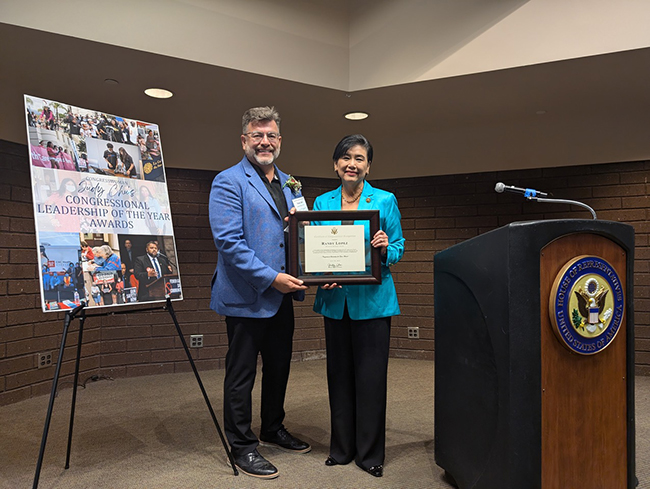It’s done: City Council approves housing element

Council member Corey Calaycay speaks during Tuesday's council meeting. Courier photo/Steven Felschundneff
by Steven Felschundneff | steven@claremont-courier.com
It’s fitting in a way that it took nearly eight hours to get the job done, but early Wednesday morning the Claremont City Council finally approved an update to the city’s housing element, ending a 20-month saga to bring the city back into compliance with state law.
Just before 2 a.m. the council voted 3-2 to approve a resolution adopting the 2021-2029 housing element update and certifying an associated environmental impact report. Mayor Ed Reece and council member Corey Calaycay voted no.
The City Council also directed staff to work with the California Department of Housing and Community Development to explore whether state officials would conditionally certify the housing element update if it were amended to incorporate several changes that were supported by two council members.
Mayor pro tem Sal Medina asked for a 50% reduction in the density at a proposed development at 840 S. Indian Hill Blvd., “opportunity site 40” in the document, which was a key ask from his constituents in District 5.
Reece asked for reduced density at four sites in his northern Claremont district and that staff work to find alternate sites, provided this change did not reduce the total number of units in north Claremont.
These proposed changes would be incorporated into the rezoning process associated with the housing element. But there is no guarantee the Department Housing and Community Development will agree. This is a crucial detail, because even though the council approved the housing element, it won’t be certified by the state until all of the rezoning is completed, and it’s unknown what affect the amendment requests will have on final certification. The rezoning must be completed in the next 120 days.
Because Claremont had been out of compliance with its housing element for so long, the city was sued last year by Californians for Homeownership in an effort to force the city to get the document approved. That suit was settled earlier this year, but a resulting judgment meant the city had to adopt its housing element by July 31. If Claremont had failed to meet that deadline it faced significant fines and the threat of further litigation.
Tuesday’s meeting began with a musical chairs-like exercise during which three council members had to recuse themselves because property or business interests created a conflict of interest regarding certain parcels included in the housing element.
Mayor Reece as well as council members Calaycay and Medina had to leave the room one at a time so the other four could discuss whether to include the conflicted sites in the final housing element. Medina participated remotely so when his turn came he turned off his camera and microphone. All of these sites remained in the final document.
Claremont Senior Planner Nik Hlady had the unenviable task of presenting the staff report and then standing for hours responding to questions from both the council and members of the public.
To arrive at the final approved version of the sixth cycle housing element, the city went through multiple rounds of public meetings beginning in December 2020. There have been five draft versions, each of which was submitted to the California Department of Housing and Community Development and returned with a list of necessary changes. The draft which was approved by the planning commission on June 6 had the unofficial seal of approval from the state that, barring any changes, carried an assurance the city would finally be in compliance.
To reach that threshold, the city had to add opportunity sites in the northernmost part of Claremont. This request was made in conjunction with AB 686, the Affirmatively Furthering Fair Housing act, which, among other provisions, requires municipalities to include opportunity sites in areas with the highest resources. Up until the final version, there were no opportunity sites in this area of Claremont, but the inclusion of these parcels late in the game left residents in this neighborhood feeling blindsided, and they came out in force to express their displeasure.
Claremont’s final map includes 31 opportunity sites spread throughout the city, although the majority are centered around busy corridor streets that offer access to transportation and services.
State legislation encouraged new affordable housing
Since 2017, the state has been aggressive in passing new legislation aimed at encouraging the production of new affordable housing. This includes stricter requirements to justify the viability of housing opportunity sites, a requirement to add a 15% buffer to the Regional Housing Needs Assessment allocation, and that the housing element must foster inclusive communities and “overcome patterns of segregation.”
The six-county Southern California Council of Governments’ total allocation under the Regional Housing Needs Assessment is 1,341,827 new housing units, including homes for a range of low-income residents. Claremont’s plan includes 1,711 units, including 556 extremely low-income units, 310 low income, 297 moderate income and 548 above moderate.
The city must demonstrate adequate capacity to meet the housing targets identified through the RHNA process. If its “current regulatory regime” does not provide for sufficient capacity, then it must rezone parcels within the opportunity sites to increase density. Of the 44 parcels that make up the 31 opportunity sites, 27 had to be rezoned.

The Claremont City Council chamber was packed with concerned residents Tuesday as it considered an update to its housing element. Courier photo/Steven Felschundneff
Calaycay began the council discussion with a series of pointed questions about the apparent contradictions in current state housing law. However, when it came time for the council to debate the housing element itself, he repeated his general frustrations with state law, particularly rules that leave local elected officials looking like the bad guy for decisions that come from Sacramento.
“I have always considered myself to be a pragmatist but it’s hard to be a pragmatist when essentially I feel like the choices that are being given to me are, ‘Do you want to drink poison, do you want to get stabbed, [or] do you want to get shot?’” Calaycay said.
He said in adopting a housing element the choices are getting more complicated and difficult with each wave of new legislation coming from the state. That also seems to make the whole process moot while still aggravating the people affected by the council’s decisions.
“I want to remind everybody why we’ve got problems,” Calaycay said. “Every problem we have in this city right now is because of the damn state of California. I am just going to say it and put it out there. I am so sick and tired of this.”
Calaycay also expressed a desire to see the Claremont community rise above the strife.
“I hope in spite of how these issues are putting us at odds, we still need to find a way to be cordial with one another and respectful with one another because the only way we are going to solve our problems is to continue talking and hopefully coming to some reasonable understanding and consensus on what is really going to help us and what is not helping us.”
Calaycay also expressed skepticism that building more housing would ever solve the affordability problem in California.
“One of the benefits we have is the opportunity to wrestle with these decisions and do our best to not make it political,” Council member Jennifer Stark said. “Because when we make it political, we start looking at each other like one person is right and another is wrong.
“We’re tasked with a difficult job; we knew that when we asked to be able to do this from the people who voted us in. We have to do the best we can, to defend the reasons why we are supporting the different sites. And I think deferring to the staff’s expertise and hours spent in conversation with HCD is a one of the really good metrics.”









0 Comments